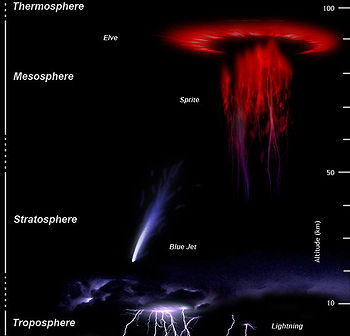
Aeronomy
Encyclopedia
Aeronomy is the science of the upper region of the atmosphere
, where dissociation
and ionization
are important. The term aeronomy was introduced by Sydney Chapman, and the above definition stems from 1960. Today the term also includes the science of the corresponding regions of the atmospheres of other planets. Aeronomy is a branch of atmospheric physics
. Research in aeronomy requires access to balloons, satellites, and sounding rockets which provide valuable data about this region of the atmosphere. Atmospheric tide
s dominate the dynamics of the mesosphere
and lower thermosphere
. Therefore, understanding of atmospheric tides is essential to understanding the atmosphere as a whole. Other phenomena studied are upper-atmospheric lightning
discharges, such as red sprites
, sprite halos, blue jets, and elves.
s form an important mechanism for transporting energy input into the lower atmosphere from the upper atmosphere, while dominating the dynamics of the mesosphere and lower thermosphere. Therefore, understanding the atmospheric tides is essential in understanding the atmosphere as a whole. Modeling and observations of atmospheric tides are needed in order to monitor and predict changes in the Earth's atmosphere.

Upper-atmospheric lightning
or upper-atmospheric discharge are terms sometimes used by researchers to refer to a family of electrical-breakdown phenomena that occurs well above the altitudes of normal lightning
. The preferred current usage is transient luminous events (TLEs) to refer to the various types of electrical-discharge phenomena induced in the upper atmosphere by tropospheric lightning. TLEs include red sprites, sprite halos, blue jets, and elves.
Atmosphere
An atmosphere is a layer of gases that may surround a material body of sufficient mass, and that is held in place by the gravity of the body. An atmosphere may be retained for a longer duration, if the gravity is high and the atmosphere's temperature is low...
, where dissociation
Dissociation (chemistry)
Dissociation in chemistry and biochemistry is a general process in which ionic compounds separate or split into smaller particles, ions, or radicals, usually in a reversible manner...
and ionization
Ionization
Ionization is the process of converting an atom or molecule into an ion by adding or removing charged particles such as electrons or other ions. This is often confused with dissociation. A substance may dissociate without necessarily producing ions. As an example, the molecules of table sugar...
are important. The term aeronomy was introduced by Sydney Chapman, and the above definition stems from 1960. Today the term also includes the science of the corresponding regions of the atmospheres of other planets. Aeronomy is a branch of atmospheric physics
Atmospheric physics
Atmospheric physics is the application of physics to the study of the atmosphere. Atmospheric physicists attempt to model Earth's atmosphere and the atmospheres of the other planets using fluid flow equations, chemical models, radiation balancing, and energy transfer processes in the atmosphere...
. Research in aeronomy requires access to balloons, satellites, and sounding rockets which provide valuable data about this region of the atmosphere. Atmospheric tide
Atmospheric tide
Atmospheric tides are global-scale periodic oscillations of the atmosphere. In many ways they are analogous to ocean tides. Atmospheric tides can be excited by:*The regular day/night cycle in the insolation of the atmosphere...
s dominate the dynamics of the mesosphere
Mesosphere
The mesosphere is the layer of the Earth's atmosphere that is directly above the stratosphere and directly below the thermosphere. In the mesosphere temperature decreases with increasing height. The upper boundary of the mesosphere is the mesopause, which can be the coldest naturally occurring...
and lower thermosphere
Thermosphere
The thermosphere is the biggest of all the layers of the Earth's atmosphere directly above the mesosphere and directly below the exosphere. Within this layer, ultraviolet radiation causes ionization. The International Space Station has a stable orbit within the middle of the thermosphere, between...
. Therefore, understanding of atmospheric tides is essential to understanding the atmosphere as a whole. Other phenomena studied are upper-atmospheric lightning
Upper-atmospheric lightning
Upper-atmospheric lightning or upper-atmospheric discharge are terms sometimes used by researchers to refer to a family of short-lived electrical-breakdown phenomena that occur well above the altitudes of normal lightning and storm clouds. Upper-atmospheric lightning is believed to be electrically...
discharges, such as red sprites
Sprite (lightning)
Sprites are large-scale electrical discharges that occur high above thunderstorm clouds, or cumulonimbus, giving rise to a quite varied range of visual shapes flickering in the night sky. They are triggered by the discharges of positive lightning between an underlying thundercloud and the...
, sprite halos, blue jets, and elves.
Atmospheric tides
Atmospheric tideAtmospheric tide
Atmospheric tides are global-scale periodic oscillations of the atmosphere. In many ways they are analogous to ocean tides. Atmospheric tides can be excited by:*The regular day/night cycle in the insolation of the atmosphere...
s form an important mechanism for transporting energy input into the lower atmosphere from the upper atmosphere, while dominating the dynamics of the mesosphere and lower thermosphere. Therefore, understanding the atmospheric tides is essential in understanding the atmosphere as a whole. Modeling and observations of atmospheric tides are needed in order to monitor and predict changes in the Earth's atmosphere.
Upper-atmospheric lightning

Upper-atmospheric lightning
Upper-atmospheric lightning
Upper-atmospheric lightning or upper-atmospheric discharge are terms sometimes used by researchers to refer to a family of short-lived electrical-breakdown phenomena that occur well above the altitudes of normal lightning and storm clouds. Upper-atmospheric lightning is believed to be electrically...
or upper-atmospheric discharge are terms sometimes used by researchers to refer to a family of electrical-breakdown phenomena that occurs well above the altitudes of normal lightning
Lightning
Lightning is an atmospheric electrostatic discharge accompanied by thunder, which typically occurs during thunderstorms, and sometimes during volcanic eruptions or dust storms...
. The preferred current usage is transient luminous events (TLEs) to refer to the various types of electrical-discharge phenomena induced in the upper atmosphere by tropospheric lightning. TLEs include red sprites, sprite halos, blue jets, and elves.

